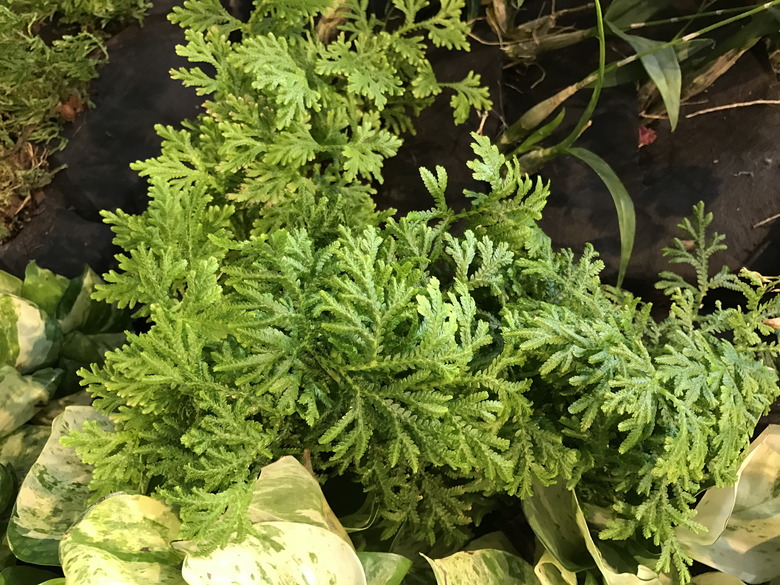How To Care For Frosty Fern Plants
Frosty ferns (Selaginella kraussiana, USDA zones 11-12) earned their common name from the subtle cream-colored variegation of their foliage, which lends them a slightly silvery appearance. Because they're hardy in only the warmest climate zones, these plants usually make an appearance as houseplants in dish gardens or terrariums indoors. They can also grow outside during warm weather, but their containers must be moved indoors when cold weather returns in autumn. Whether indoors or out, frosty ferns require little upkeep or care.
Frosty Fern Confusion
The frosty fern is sometimes referred to as a moss fern or holiday fern, but the plant is neither a fern or a moss. It earned both names based on its appearance rather than its taxonomy. Frosty ferns are actually a type of spike moss, but spike mosses aren't really moss either. Unlike true moss, spike mosses have roots and leaves.
Because these plants often appear in supermarkets and other stores around Christmastime, people sometimes refer to the frosty fern as a Christmas fern. This is incorrect, as a true Christmas fern is another plant entirely, known botanically as Polystichum acrostichoides (zones 3-9).
Soil and Planting
Indoors, the frosty fern likes bright but indirect light. Outside, it prefers shade. These plants also like well-drained but continually moist soil with a pH level between 5.5 and 6. Any high-quality potting soil will do the trick indoors or in containers, but heavy outdoor soils that drain slowly will need amended.
Keep It Damp
Soil moisture and humidity are equally important when caring for frosty ferns. Low humidity causes browning foliage and unsightly shriveling, while inadequate soil moisture can cause serious stress damage and premature death. Water frosty ferns whenever their soil feels nearly dry on the surface. For potted plants, pour water into the pot until a small amount dribbles from the drainage holes.
Reduce watering by one-half during the fall and winter. Maintain humidity above 50 percent at all times to keep the foliage looking its best. The easiest way to do so is to place the plant on a tray of water and pebbles, keeping the bottom of the pot above the water level. You can also mist frosty ferns with distilled or rain water daily, or several times each day during hot, dry weather.
Just a Trim
The dense, 6- to 12-inch-tall foliage of frosty ferns doesn't need routine trimming or pruning. To keep your plant looking its best, however, you can remove faded foliage or unruly growth.
Snip off any undesirable stems using small, sharp scissors. Wipe the blades with rubbing alcohol before making each cut to help prevent the spread of disease. Do not shear or prune back frosty ferns too heavily because it may cause trauma and a permanent unsightly change in shape and appearance.
Frosty Fern Nutrient Needs
Frosty ferns are light feeders and do not require fertilizer if planted in acidic, organically rich soil. Older plants may benefit from light weekly fertilizer applications during the active growing season to promote more vigorous growth. Too much fertilizer can harm frosty ferns, so you'll need to use a weak solution to avoid root burn.
Use a liquid 10-10-10 or 12-12-12 houseplant fertilizer diluted at a rate of 1/4 teaspoon per 1 quart of water, or one-fourth of the rate recommended on the label. Apply the solution to moist soil each week during the spring and summer. Don't pour the fertilizer solution directly onto the plant and stop feeding if the frosty fern yellows or shows other signs of stress.
Potential Plant Problems
Frosty ferns suffer few problems. Insect pests and disease issues are rare and those that occur are seldom serious. The most common and pervasive issues with frosty ferns occur when their growing conditions are poor or if they are exposed to a sudden change in humidity, temperature or sun.
Yellow, dried-out or limp foliage indicates sunburn, dry soil or dry air. Move affected plants to deeper shade and water them deeply with distilled water. Most frosty ferns perk up when given water but their growth may slow as their roots recover.
References
- American Horticultural Society Encyclopedia of Plants and Flowers; Christopher Brickell
- Logee's Plants for Home and Garden: Cultural Information — Selaginella
- University of Idaho Extension: Pruning Tools
- Hoeticulture: Frosty Fern: Another New Holiday Houseplant
- Gardenerdy: The Gardening Secret of How to Care for a Frosty Fern Plant Revealed
- Monrovia: Christmas Fern
- New Hampshire PBS: Bryophytes
